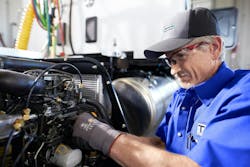This is Part Two of a two-part story. Click here to see Part One.
With the wealth of data available to techs nowadays, applying vehicle data to troubleshooting and repairs is not just a luxury, but a neccessity. In Part One of this story, we discussed how technicians can use historical repair data to anticipate vehicle issues with valuable contextual knowledge and by logging symptoms over time.
Both of these tactics can offer hints into a vehicle's true health over time, but data is only helpful if technicians are able to find and understand the diagnostic codes they need. Here's how to approach diagnostics and use Vehicle Maintenance Reporting Standards coding to reveal trends and issues in a fleet.
Digging into diagnostics
Diagnostic codes take on even more importance as technology becomes more complex. Bob Roberts, leader of technical operations for Thermo King, said the codes are how transportation refrigeration units tell technicians where their pain points are. “Reefer units today are much more sophisticated than in years past, and manufacturers are incorporating intelligence within the microprocessor to see when the unit is not operating as designed and then alerting technicians of the issue and, in many cases, what the specific cause of the problem is,” he said.
Looking at diagnostic information before beginning a repair can save technicians time in the long run. A client of Danny Colon, co-owner of Dedicated Diagnostics, recently exhibited symptoms of a potential injector issue. “While many technicians might have instinctively proceeded to replace the injector, we took a different approach guided by repair data and systematic diagnostic processes,” he said.
The technician turned to JPRO’s wiring diagrams and troubleshooting steps, tracing the issue back to its root cause, which was an intermittent internal fault within the vehicle’s computer (ECU). “This fault only manifested under specific conditions, which explained the sporadic nature of the issue,” Colon said. “By diagnosing the entire system from the ECU to the harness and all the way to the injector, we provided our client with a swift and accurate diagnosis.”
Jason Hedman, product manager for Noregon, said Noregon’s JPRO diagnostic tool pulls together historical data from any time JPRO is connected to that vehicle as part of its Fault History feature. That history and the associated diagnostic data can be instrumental in detecting and troubleshooting intermittent faults—faults that trigger between active and inactive and, therefore, show up intermittently.
If an issue is caused by a shorted wire, it would make sense the light flickers while on a bumpy road but not in the shop, which could have led the previous tech to simply clear the fault and move on. “Technicians can use fault history to see historical connections and look at inactive faults to confirm this is an intermittent issue that has been present for a while,” Hedman said.
JPRO also allows technicians to monitor data values from different vehicle components simultaneously. “Because issues on one system can affect another, it’s very beneficial to monitor these values and see how they react to the actions taken by the tech,” Hedman said.
If technicians want to pinpoint which wiring harness is causing an issue, they could monitor values from multiple systems while they perform a wiggle test. JPRO will let them know when those values deviate outside their standard range, leading the technician to begin their diagnostics on that specific harness.
On the analog side, Iron Buffalo has invested in a smoke machine to streamline leaks that can be difficult to diagnose. Ian Matje, a technician and director of training for Iron Buffalo, recently had a newer Ram truck with an aftertreatment system that was melting the diesel exhaust fluid doser and the line that injects DEF into the exhaust system.
“We found an exhaust leak, but nothing was visible because it was after the DPF,” Matje said, explaining that the leak was putting the doser and line in direct contact with 1,100-degree F temperatures. “It is pretty dangerous to put your hands around those areas to feel for exhaust leaks. The smoke machine makes it visible and safe.”
Read more: How processes and guidelines improve repair quality
The smoke machine also helps techs uncover leaks in other areas, including intake systems, air systems, cooling systems, and oil systems. “You can even use it for interior leaks like wind noises or water getting into cabs,” Matje said. “If you have aftertreatment codes or low power complaints, it is a quick way to plug in and verify a problem.”
Creating a common language
When everyone speaks the same language, spotting trends and issues becomes easier, which is why VMRS can be beneficial. “If I’m in a fleet and have a vehicle configuration where I’m seeing a common failure, it is going to be more visible with VMRS coding,” said Kristy Coffman, director, commercial vehicle group for Mitchell 1. “Those codes will eliminate a lot of noise regarding what happened with the repair.”
Jack Poster, VMRS services manager for the American Trucking Associations’ Technology and Maintenance Council, said VMRS makes it easier to recall past labor and parts that were used. “The computer understands numbers better than words,” he said, adding that codes eliminate the potential for misspellings or regional terminology. “Some people call it a backup switch and some call it a neutral safety switch. It could be an ABS ring or a toner ring. A lot of it depends on where you work and who you work with.”
VMRS comprises 65 separate code keys, with Poster calling it an “encyclopedia made up of different areas.” Most people are aware of the nine-digit component codes, but there are also codes for manufacturers, suppliers, brands, failures, work accomplished, and more. “You can string the different code keys together and come up with a wealth of information,” he explained.
Maverick’s Mitchell said he relies heavily on VMRS codes and audits the company’s VMRS data regularly. “We use it for parts and labor, and that rolls up to how we have our general ledger coded. Whenever monthly expenses rise in one division or another—tires, accessory items, or other components—we’ll investigate why the line item went up. By digging into VMRS, we can see if there is a driver issue or if the cost of a part increased.”
Poster said VMRS Code Key 82 can be used for DVIRs to help eliminate errors. “A lot of service providers use that when they’re talking about the maintenance event to the driver. When you’re behind the counter getting information, if you’re not transposing what the driver says correctly, you’re leading technicians down a blind alley. It is important to get the correct information.”
Work on VMRS is ongoing, and TMC has started working on coding for maintenance labor alerts before the vehicle or piece of equipment comes into the shop. “A lot of the equipment is talking to you and saying, ‘My alternator is failing’ or ‘I need an oil change.’ We are working with OEs and 50-plus different companies on the new code key,” Poster said. “You’re going to know what is going on and what needs to be done before the vehicle arrives in your shop.”
Thermo King uses Standard Repair Times, which Roberts said is the transport refrigeration industry’s equivalent to VMRS codes. SRT codes establish which repairs are required to complete a certain job and how much time will be allotted to complete the repair while the unit is under warranty.
Thermo King has also created inclusive job codes. “Typically, most repairs would require multiple actions—SRTs—to complete the task,” Roberts said. “If those tasks are consistent from repair to repair, we will create an inclusive job code that will contain all the individual SRTs required to complete the repair. This goes a long way in assisting our dealers with which repairs are associated with a casual part failure.”
Planning ahead
Repair history, diagnostic codes, and repair manuals can allow technicians to look at recommended processes before beginning their work and determine if they have the skill sets to perform the repairs.
“There are times that looking at it can help you identify who is best suited to do that,” Coffman said. “One customer looked at the repair information ahead of time and determined they were better off to turn it back to the dealer. It saved hours and days of their best technician’s time.”
Repair data and previous work orders also provide context for techs to select the appropriate tools and equipment. “This knowledge helps us make informed decisions on diagnostic procedures and tool usage, ensuring accurate diagnosis and effective repairs,” Colon explained.
Coffman said capturing, organizing, and ensuring information remains accessible for future reference is the key to increasing efficiency and improving performance. “A vehicle isn’t much different than us with our bodies. If I have something going on, it can be a new issue, or there are oftentimes the issues are related to or brought about by something previous,” she said. “Having the history lets the vehicle communicate with us.”

